NVIDIA GeForce GTX 670 Review Feat. EVGA: Bringing GK104 Down To $400
by Ryan Smith on May 10, 2012 9:00 AM ESTOC: Power, Temperature, & Noise
Our final task is our look at GTX 670’s overclocking capabilities. Based on what we’ve seen thus far with GTX 670, it looks like NVIDIA is binning chips based on functional units rather than clockspeeds. As a result GTX 670 could have quite a bit of overclocking potential, albeit one still limited by the lack of voltage control.
| GeForce 600 Series Overclocking | |||||
| GTX 670 | EVGA GTX 670SC | GTX 680 | |||
| Shipping Core Clock | 915MHz | 967MHz | 1006MHz | ||
| Shipping Max Boost Clock | 1084MHz | 1188MHz | 1110MHz | ||
| Shipping Memory Clock | 6GHz | 6GHz | 6GHz | ||
| Shipping Max Boost Voltage | 1.175v | 1.162v | 1.175v | ||
| Overclock Core Clock | 1065MHz | 1042MHz | 1106MHz | ||
| Overclock Max Boost Clock | 1234MHz | 1263MHz | 1210MHz | ||
| Overclock Memory Clock | 6.9GHz | 6.6GHz | 6.5GHz | ||
| Overclock Max Boost Voltage | 1.175v | 1.162v | 1.175v | ||
Because of the wider gap between base clock and boost clock on the GTX 670 we see that it doesn’t overclock quite as far as GTX 680 from a base clock perspective, but from the perspective of the maximum boost clock we’ve slightly exceeded the GTX 680. Depending on where a game lands against NVIDIA’s power targets this can either mean that an overclocked GTX 670 is faster or slower than an overclocked GTX 680, but at the same time it means that overclocking potential is clearly there.
We’re also seeing another strong memory overclock out of a GK104 card here. GTX 680 only hit 6.5GHz while GTX 690 could hit 7GHz. GTX 670 is only a bit weaker at 6.9GHz, indicating that even with the relatively small PCB that NVIDIA can still exceed the high memory clocks they were shooting for. At the same time however this is a luck of the draw matter.
The EVGA card meanwhile fares both worse and better. Its gap between the base clock and and maximum boost clock is even larger than the reference GTX 670, leading to it having an even lower overclocked base clock but a higher overclocked maximum boost clock. The real limiting factor however is that it couldn’t reach a memory overclock quite as high as the reference GTX 670 – again, luck of the draw – which means it can’t match the overclocked reference GTX 670 as it’s going to be more memory bandwidth starved more often.
Moving on to our performance charts, we’re going to once again start with power, temperature, and noise, before moving on to gaming performance. We’ll be testing our GTX 670 cards at both stock clocks with the maximum power target of 122% (170W) to showcase what is possible at validated clockspeeds with a higher power cap, and a true overclock with a maximum power target along with the largest clock offsets we can achieve.
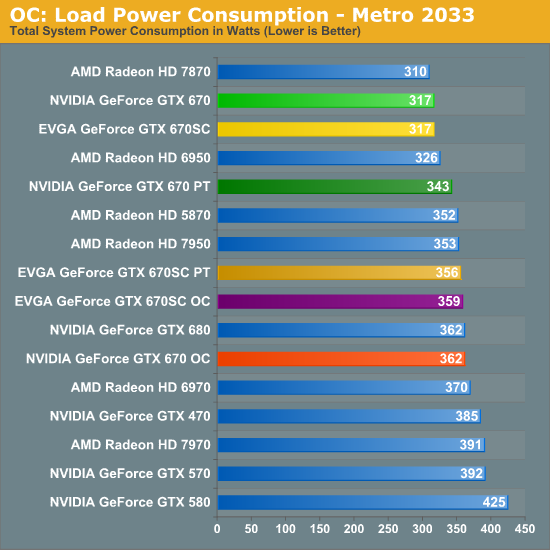
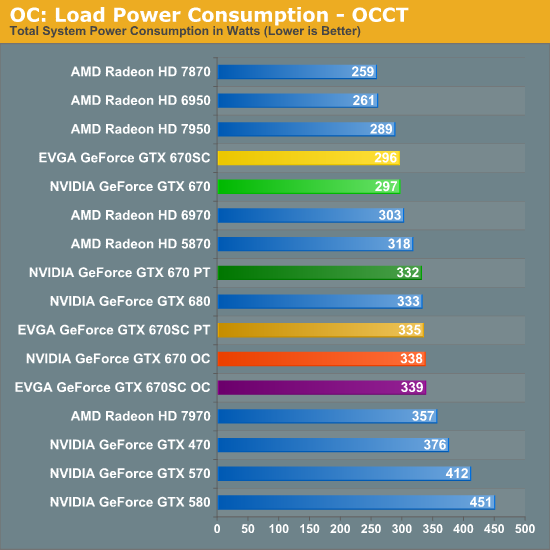
Not surprisingly, since we’re almost always operating within the realm of the power target as opposed to the TDP on the GTX 600 series, our power consumption closely follows our chosen power target. Cranking up the power target on the GTX 670 for example to 170W puts us within 6W of the GTX 680, which itself had a 170W power target in the first place. This is true for both Metro and OCCT, which means power consumption is very predictable when doing any kind of overclocking.
This also means that power consumption is still 18W-30W below the 7970, which in turn means that if these overclocks can close the performance gap, then the GTX 670 still has a power consumption advantage.
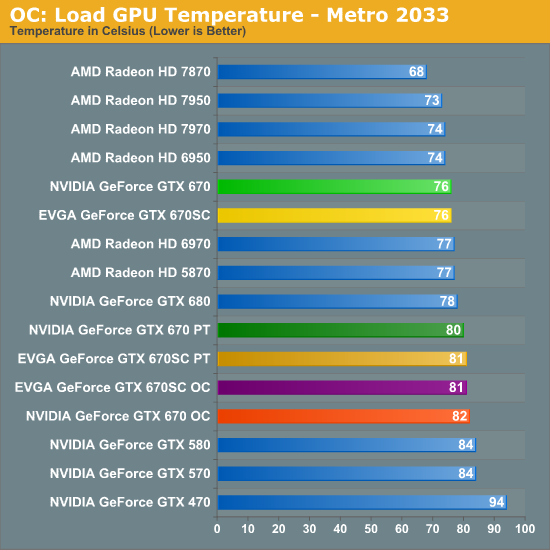
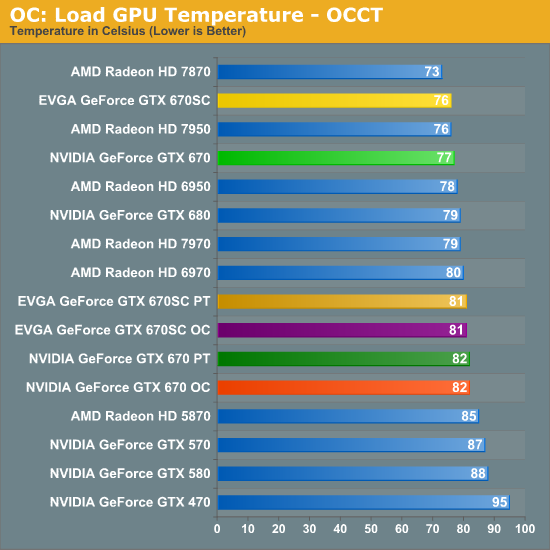
As to be expected, with an increase in power consumption comes an increase in load temperatures. However the fact that we’re only able to increase power consumption by about 30W means the temperature rise is limited to 4-5C, pushing temperatures into the low 80s. This does end up being warmer than the equivalent GTX 680 however due to the 680’s superior heatsink.
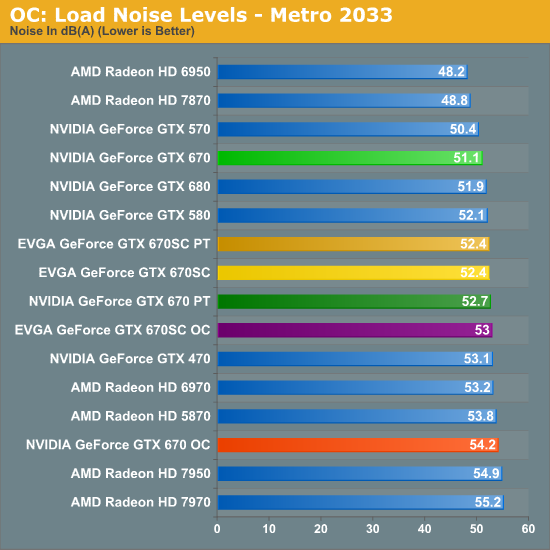

Finally, when it comes to noise we’re also seeing the expected increase, but again it’s rather small. Under Metro the amount of noise from the reference GTX 670 rises by under 3dB when pushing the power target higher on its own, while it rises 3dB when adding in our full overclock. Again the smaller cooler means that the GTX 670’s fan has to work harder here, which means our gaming performance may be able to reach the GTX 680, but our noise is going to slightly exceed it. As a point of reference, in the process we’ll also exceed the GTX 580’s noise levels under Metro. Still, in both OCCT and Metro none of our GTX 670 cards exceed the Radeon HD 7900 series, which means we've managed to increase our performance relative to those cards without breaching the level of noise they generate in the first place.










414 Comments
View All Comments
CeriseCogburn - Sunday, May 13, 2012 - link
Are you going to put up with crashing amd drivers and a burning electric bill OC with added instability and a water tower cost and then all of a sudden save a miniscule bit on card cost ? Are you going to add to your suffering with no adaptive v-sync, no also added smooth frame rate target, no instant per game optimum settings from a massive nVidia server farm embedded automagically in the superior nVidia drivers ?Are you going to stand for no bezel peek feature ?
Are you going to put up with the more expensive and hassled 3 monitor connection issues of the amd cards ?
Are you going to sit there undisturbed by the epic failure of amd 3D gaming vs Nvidia's available and awesome implementation ?
Are you going to put up with no amd 120hz monitor support there too ?
Isn't your original stance there the very opposite of "no one buys these cards to run on just one monitor and certainly not 1900x1200" argument ?
Since the amd overlcocks "so well" as you claim vs nVidia, what is amd releasing a pre overclocked version going to do other than allow amd partners to charge more ?
ROFL - it will do nothing.
saturn85 - Monday, May 14, 2012 - link
the folding@home benchmark is great!!i think the performance unit "point per day (ppd)" is preferable compare to "nanosecond per day (ns/day)".
TheMan876 - Tuesday, May 15, 2012 - link
Glad to see 3 monitor resolutions getting benchmarked since I just moved to that setup. Can't wait to see SLI on this card!Death666Angel - Thursday, May 17, 2012 - link
Prices for the GTX 670 and the HD 7970 are similar in Germany, at max a difference of about 30€. :-)If I had to buy a card today, I'd probably get a GTX 680, but I don't regret the 500€ I spent on a 7970 with a watercooling block and OC capabilities of 1300/1700. :-)
Brainling - Thursday, May 24, 2012 - link
I had been waiting patiently for the release of the 670 or the 660ti, depending on availability, cost and performance. After reading this review of the 670, I bought one on the spot (release day morning, while Newegg still had some)....it was a good decision.This card replaced an HD6870, and while that was a decent card, it's like night and day. In informal tests I did, I found this card to be twice as powerful in most scenarios. Nvidia has really outdone themselves with their new Kepler architecture. They've created one of the most powerful hyper-parallel architectures available to do, and have done so at greatly decreased power draw and heat (aka: less noise). It's rare to ever see my 670 spike above 60C, with the stock blower cooler.
All in all a great purchase, and one I'm very glad I made.
smartypnt4 - Sunday, May 27, 2012 - link
I know they're on the site in other reviews, but it would be nice if you could include a few dual-GPU cards in the benchmark comparisons. It probably only matters to a few people like me, but it'd be nice to have.For me, I want them because I'm trying to make a decision: do I get a second 6950 to crossfire with the one I already have for $200, or do I go out and buy a new card?
From what I've seen, outside the edge case games such as Batman and some of the games running on Frostbite, a 6990 pretty much trades blows with the 680 and the 7970. So, I'm thinking that for me, since I have the headroom in my PSU, getting a second 6950 makes a whole lot of sense, even though the setup will consume almost twice as much power as one new card.
Just my two cents.
codeus - Monday, June 4, 2012 - link
Good review but so much focus on EVGA's warranty changes smacks of this being a sponsored (and therefore biased?) review.pilotofdoom - Monday, June 11, 2012 - link
Anyone else notice that the GTX 670 outperformed the GTX 680 in the Microsoft’s Detail Tessellation test on Normal settings?I'm guessing it's a simple mistake, since there's no mention of the reversal in the text. Not like it really matters anyways, being a synthetic benchmark compared to actual gaming performance.
chrisrobhay2 - Friday, June 29, 2012 - link
Which leader does Anandtech use for the Civilization V Compute test? I'm just curious because my overclocked GTX 670 wipes the floor with all of these cards in almost all of the leader tests, so I want to make sure that I'm looking at the right information.warmbit - Tuesday, July 17, 2012 - link
If you want to see what we really have GTX670 performance in games is worth taking a look at this overview:http://warmbit.blogspot.com/2012/05/analiza-wyniko...
On the right side, select your language for translation (Google Translate).